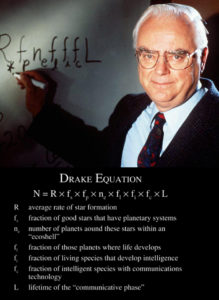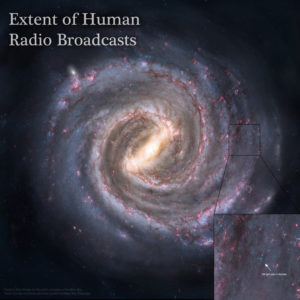SETI AND THE DANGERS OF MAGICAL THINKING
An Essay, May 19, 2020
***
“The universe is a pretty big place. If it’s just us, seems like an awful waste of space.”
― Carl Sagan, Contact
***
Scientists at the University of Nottingham have recently speculated that there could be as few as 36 ‘communicable’ civilizations in the Milky Way Galaxy. That’s really disappointing news, dropping even the most optimistic chances of contacting another intelligence in our own galaxy to nearly zero.

By using the ‘Principle of Mediocrity,’ the scientists in Nottingham made the logical assumption that the Earth wasn’t particularly novel since our solar system itself proves that the conditions for life are not unique to Earth. In fact, we know there are no less than five celestial bodies in our solar system alone that could have harboured life at some point in their history.(1) If the conditions for life are not particularly novel, and life evolved on Earth, then the researchers assumed life would eventually evolve anywhere the conditions were right given sufficient time. They assumed sufficient time was on the same timescale as us; over 5 billion years. According to Wikipedia, “for Earth to host the only civilization in our galaxy for all time, the odds of a habitable zone planet ever hosting intelligent life must be less than 1.7×10−11 (about 1 in 60 billion).” Such a big number suggests that it’s far more likely than not that other technological civilizations have evolved in our galaxy in the past, and that well over thirty could exist concurrent to our own.
The scientists in question have updated what we know as the ‘Drake Equation’, a speculative framework created by Dr. Frank Drake, (now Emeritus Professor of Astronomy and Astrophysics at U of C, Santa Cruz) for a conference in 1961 at the Green Bank Radio Telescope in West Virginia, where he worked as a radio astronomer. His objective was to try to determine what the parameters might be for a systematic search for extra-terrestrial intelligence (SETI).

Drake’s equation took into account the percentage of habitable stars in the universe, the percentage of those with habitable planets, the percentage those that develops life, and the percentage those that develops technology. But it was never intended to predict the possibility of life in the universe, only a discussion guide for the conference. Despite its veneer of scientific credibility, Dr. Drake always knew its predictive capability was limited and always would be. After all, it was created an entire generation before we had any evidence that planets even existed outside our own solar system, never mind the discovery of dark matter, dark energy, and dark flow.
So if there are currently thirty or so concurrent, technologically-developed civilizations in the galaxy, then why have we not detected them? This is what’s referred to as ‘the great silence’ or the Fermi Paradox, which was posed by renowned physicist Enrico Fermi when he questioned the logical inconsistency between what we calculate the population of the galaxy might be, and the deafening silence we have encountered in our observations. “Dove sono loro?” he allegedly asked. “Where are they?”(2)
The best answer to this question came from the equally renowned (and only slightly less brilliant) science fiction writer Douglas Adams who offered us the following explanation: Space is big. And if you ask any astrophysicist, I’m sure they would agree. Since astrophysicists are a bit thin on the ground most days, let me try to explain what Mr. Adams was trying to say when he offered his understated reply to Mr. Fermi’s question.
“Space is big. You just won’t believe how vastly, hugely, mind-bogglingly big it is. I mean, you may think it’s a long way down the road to the chemist’s, but that’s just peanuts to space.”
― Douglas Adams, The Hitchhiker’s Guide to the Galaxy

When it comes to communicating with extra-terrestrial civilizations, there are two possible scenarios: We could receive a response to our own signals, or we could stumble on their signals. In either case, someone would have to be listening for a signal. This process, called passive signal gathering, was not even technically possible until the early 1950s and no organized effort was attempted until the 1980s.
We had been broadcasting a signal of sufficient power into space for more than half a century by that time. So maybe somebody heard us babbling away in our planetary nursery and tuned in to investigate.

The first narrow-band radio broadcast powerful enough to reach another planet was generated by Nicola Tesla from the Wardenclyffe Tower in 1903 when he attempted to communicate with a similar tower in Scotland using wireless radio signals.(3) There has been a steady radio signal emanating from Earth nearly constantly since that time. At the speed of light, that forms a sphere, our Electromagnetic Bubble, of about two hundred light-years across. When considering such vast distances, the inverse square law needs to be factored in, guaranteeing that our signal will get weaker and weaker as it travels, making it ever more difficult to detect the further out it goes. The other end of the Milky Way Galaxy is about 200,000 light years from us. That means that it would take another 199,900 years for our signal to travel across the galaxy. To give an idea how far that is, if our EM bubble is the size of the period at the end of this sentence, then the other side of our galaxy is just under a metre (40 inches) away.

But let’s say our signal made it to a civilization on the other side of the galaxy, it would take another 200,000 years for them to reply unless they had some unimaginable technology to circumvent the distances involved. Not many of us individuals would be around by then, even if our civilization itself was still viable. Randomly distributing thirty or so concurrent civilizations over the vast expanse of the Milky Way Galaxy leaves only the smallest chance that we will ever hear from any one of those civilization. Even if we were still around to eventually hear a message from such a civilization, the chances are that it would no longer exist. The odds are just too high that it would have succumbed to a natural or self-inflicted disaster long before the signal ever got to us. The signal would be far too old to allow for meaningful communication; their radio signals the only remnant of their civilization to make it out here to the edge of the galaxy.
So as far as getting a reply to our signal, this unfortunately restricts us to the stars in our own cosmic neighbourhood. The number of star systems currently inside our 200 light-year EM bubble is about 25,000, most of them not visible from Earth without a very powerful telescope. The majority of the stars inside our EM bubble are unstable red dwarfs in binary or trinary star systems.(4) The overwhelming majority of these have no planets around them that we can currently detect. Still, there could be as many as 15% of these planetary systems that are similar to our own (potentially 3500 systems); those with a stable, main-sequence star, that could create an environment that would protect habitable planets. But most of these star systems that would be very foreign looking to us, with only a tiny percentage having rocky planets or moons at a place where water can exist in a liquid. We know of only about a dozen or so planets that could harbour life. (Though we have only just begun to search.) Unfortunately, this means that, barring an extreme cooincidence, the chance that a civilization capable of communication has developed within the 200 light-year range of our signal is vanishingly small. But critically, it isn’t zero.
When you think how frustrating it is to talk to someone over Skype with a bad internet connection, you can see how frustrating speaking over a century-long delay would be.
But let’s assume that there is a civilization hidden within our bubble and we received a response to Tesla’s 1903 signal today. Certainly, that would answer the biggest question of all; whether or not we are alone. But this still wouldn’t get us very far toward communicating with extraterrestrials. Such a signal would mean that the civilization responding would have sent the message as much as sixty years ago. That means that it would take 120 years just to exchange hellos. Judging by our own civilization, a lot can change in a century. When you think how frustrating it is to talk to someone over Skype with a bad internet connection, you can see how frustrating speaking over a century-long delay would be. Even if we received a message from these hypothetical alien creatures, we would be faced with two serious problems: What does the message mean (if anything) and how do we respond (if at all).

In Carl Sagan’s novel Contact (pub.1985, Simon and Shuster), an ancient civilization set up sensors in the Vega star system that responded when Earth’s radio transmissions were detected and an instruction manual (or a bootstrap program in computer terms) was downloaded to Earth to allow us to connect to the network of concurrent technological civilizations living in the galaxy.(5) To suggest a nearby system would have a terminus close to us, even one as far away as Vega (25 light years away), would literally be an astronomical coincidence. There would have to be millions of these transportation hubs scattered around the galaxy for any kind of random dispersal to bring one close enough to be within our EM bubble. Such a system presumes a huge number of civilizations spread all over the galaxy with beings transiting between one and the other, numbering the technological civilizations in the millions, not thirty or so. Sagan’s way around this was to suggest that the network had existed long before any of the current civilizations had developed. But even so, the chance of our radio waves triggering such a ‘burglar alarm’ is very unlikely. The problem is mathematical and the premise fails on the fact that the galaxy (never mind the universe) is just really, really big.
The problem is mathematical and the premise fails on the fact that the galaxy (never mind the universe) is just really, really big.
Given that we know of no response to Tesla’s incidental broadcast to the stars, what are the odds of us stumbling across the undirected signals of another civilization? This is where passive signal gathering comes in. Possibly the most ambitious attempt at passive signal gathering has been the SETI Institute.  Founded in California in 1984, the Institute uses downtime at major radio telescopes around the world to record the EM spectrum and search that data for artificial signals. The well-funded organization even has its own array of radio dishes called the Allen Telescope Array not far from San Francisco.
Founded in California in 1984, the Institute uses downtime at major radio telescopes around the world to record the EM spectrum and search that data for artificial signals. The well-funded organization even has its own array of radio dishes called the Allen Telescope Array not far from San Francisco.
One of the first problems the SETI Institute encountered is that the electromagnetic spectrum is so broad that any potential signals would be buried in the background noise from the Earth and the universe itself. It took years to develop the technology to sort through this rabble. Only recently have there been developments in computer hardware and sophisticated AI algorithms that could even begin to make sense of whatever radio noise the universe was throwing at us. Scanning billions of stars at billions of frequencies is an incredibly complicated undertaking, especially when you consider that you have no idea what the actual signal would look like or from which direction it might be coming.
Scanning billions of stars at billions of frequencies is an incredibly complicated undertaking, especially when you consider that you have no idea what the actual signal would look like or from which direction it might be coming.
When all things are considered, calling SETI a ‘shot in the dark’ is hopelessly optimistic. A shot in the dark on the 2D plane of the Earth’s surface is one thing, but a shot in the dark in the 4D universe of space-time is exponentially more unlikely. To complicate matters even further, there is the inevitable possibility that really sophisticated technological civilizations simply don’t communicate in the manner we do; perhaps by not using radio waves at all.(6) This presents the added difficulty that these civilizations might be so advanced that we could never recognize their signals as such, leaving the possibility that we have been receiving signals all along but didn’t know what they were. Like Goldilocks, we keep insisting an ever narrowing band of possibilities; that everything be just right. Unfortunately, the universe has no obligation to conform to the parameters we set. The people who developed the SETI Institute knew all this going in, but they saw the value in trying. They thought that, despite the odds being so small, we may get lucky, and I agree. I’m certainly not suggesting SETI isn’t worth doing. Quite the contrary, actually.
Some people believe that the problem of space travel is simply the technical problem of learning how to travel faster than the speed of light.
Some people believe that the problem of space travel is simply the technical problem of learning how to travel faster than the speed of light. I suppose, in a three-dimensional sense, this is true, but it is far from the only problem. It takes light more than four hours to get from the sun to the planet Jupiter and that’s only about 15% of the distance to the edge of our planetary system, never mind the edge of the heliosphere. Compare that to Voyager 1, one of our fastest spacecraft, which took more than 17 months to traverse the same distance.
As evidenced by the above video, light speed is mind-numbingly slow when it comes to the necessities of interstellar travel. There have been many imaginative ways that writers have posited as a means of overcoming this super-luminal speed limit, from ‘hyperspace’ (whatever that is) in Star Wars (wr./dir George Lucas), to ‘warp-drive’ (possible but impractical energy-wise) in Star Trek (cr. Gene Roddenberry) to ‘wormholes’ (possible but hideously dangerous) in Interstellar (wr./dir. Jonathan and Christopher Nolan) et.al.
Each of these has various degrees of scientific credibility, I suppose, but what they all have in common is that they ignore Einstein’s assertion that if you add energy to accelerate an object, it will eventually not only gain speed but will gain mass. The more mass it gains, the more energy is needed for it to accelerate until eventually both will reach infinity. Until we figure out a way around this, there is no possibly of traversing such distances.

No one has ever figured out a theoretically plausible way to travel faster than light without having to accelerate, though some have tried. The most imaginative (and certainly my favourite) means of travelling the vast distances of space is the “Infinite Improbability Drive’ Douglas Adams invented for his novel The Hitchhiker’s Guide to the Galaxy. His idea is that instantaneously jumping from one point in space to another is infinitely improbable, but (critically) not impossible. All your spaceship has to do is find the one route that was finitely probable out of those infinity of impossible routes of travelling to your destination. At first glance, this seems like a joke, (which it is) but I am beginning to think that this may be the only realistic means of human beings traversing the universe at large.

Science fiction stories like this that speculate about some magical device that will instantly transport us from point ‘A’ to point ‘B’ in space also betray a fundamental misunderstanding of relativity and space-time. Even if you were able to move from one place to the next instantly, there is still the question of the subjective nature of ‘move’ and ‘now’ to deal with.
If you want to travel to another galaxy using our conventional concept of the term ‘now’ as depicted in many space travel stories, (even the best of them) this not only requires that the space ship travel in space, but also backward in time. The state of that far-away galaxy that we perceive ‘now’ no longer exists. It is in a different place and a different time (its relative transitional coordinate in space-time) than what we refer to as ‘now’ (defined as our transitional space-time coordinate, what we call the present). Even if we could somehow travel from point ‘A’ to point ‘B’ in an instant (ie: outside of space-time), when we arrive at our destination, that destination will have transitioned to a corresponding distance into the ‘future’ (billions of years, depending on how far you travelled) even if the trip was instantaneous.

The reason for this is that ‘now’ there is not ‘now’ as we know it. What we call the present is a specific space-time coordinate and there is no way to move to a different space coordinate without also factoring in the time coordinate. If we find evidence that a civilization exists any significant distance from us, there is no practical way of us ever knowing if that civilization still exists in our present.
Maybe the best way to illustrate this is to use a time-travel story as an example. Time travel stories have existed almost since the beginning of Science Fiction, the most famous of which was H. G. Wells’ ‘The Time Machine’ (pub. 1895, William Heinemann, Ltd). The story revolves around the unnamed Traveller who develops a machine to travel backward or forward in time. The most obvious flaw in this story is that he travels 800,000 years into the future, yet he remains in the same geographical position on the Earth, despite the fact that the Earth would be thousands, millions or even billions of miles away from his starting position, depending on the relative position from which you measure that distance. Granted, Wells wrote the story ten years before Dr. Einstein developed his theory of relativity, so he didn’t know enough to account for its mind bending effects. We’ve always understood that it takes time to travel in space. But it is less obvious that, conversely, to travel in time, you also need to travel through space. That might sound a little odd, but it’s actually the way the universe works and there is simply no way that we know of to get around it.
We’ve always understood that it takes time to travel in space. But it is less obvious that, conversely, to travel in time, you also need to travel through space.
All these problems arise because we do not live in a three-dimensional universe; we live in four (or more) dimensional space-time, which literally gives the problem a whole new dimension. The universe is 13.6 billion years old. If you consider time as a dimension and use the same scale I used previously using the period of this sentence to mark out our EM bubble, then the time that has passed since the beginning of the universe would be 3500 kilometres away. Even if every technological civilization lasted ten thousand years or more (which it almost certainly won’t), this leaves the possibility that there could have been billions of technological civilizations that developed and died out during that time but whose radio signals have all died away in time. And an equal number will probably come and go once we are gone. This illustrates that time itself is at least as immense as the three dimensional universe itself, but we have no means of accessing the past or the future to search for signals.
This illustrates that time itself is at least as immense as the three dimensional space of the universe.
The mind-bending effects of relativity and time are hard for us to understand, even though we encounter the effects every day of our lives. Einstein wasn’t some alien mind grasping a concept from the universe that doesn’t really apply on Earth. He was describing what he saw every day. The problem with trying to think about how relativity effects our perception of time is that we are completely immersed in it. If fact, it’s almost impossible to describe what it would be like to be outside space-time. Our perceptual framework of the universe requires duration, so trying to think of ‘what it’s like outside of time’ is meaningless. There cannot be perceptual awareness that does not include duration. It would be like asking a character on a Blu-ray movie disc what the cover of the box looks like. If you asked an intelligent fish how wet it was, what would his answer be? Such a fish could never experience ‘dry’ without ceasing to exist in the process. It could be said that Einstein was a dolphin. He could understand what dry meant and survived to tell the tale. It’s impossible for any beings, Gods or aliens, to ‘travel in hyperspace’ because to travel anywhere requires duration. And outside of space-time, duration has no meaning.
It’s impossible for any beings, Gods or aliens, to ‘travel in hyperspace’ because to travel anywhere requires duration. And outside of space-time, duration has no meaning.
In the classic episode “Better Than Life” (Series 2, Episode 2) from the BBC sitcom “Red Dwarf” (cr. Rob Grant and Doug Naylor), the character of Rimmer (Chris Barrie) finds out his father died and grieves as if it had just happened. However, Rimmer himself had been dead for more than three millions years, as were all the people of Earth, including his father. This made little difference to the conscious awareness called Rimmer, since he was experiencing it only then.

In a simplistic way, this is what Einstein was describing with relativity. The information about his father’s death took three million years to reach him, making the reality of that death ‘now’ as opposed to three million years ago. On the surface, this seems like a silly example of twisting the meanings and context of words, rather than a real property of the universe. But it would be no different in a real-world situation.
In 1941, the military commander of the Japanese fleet in the pacific, Admiral Yamamoto, fell victim to this when he didn’t take into account the relative definitions of ‘now’ between Tokyo, Hawaii, and Washington. In Yamamoto’s mind, the government of his country had officially declared war on the United States a half hour before the attack took place; for him, a state of war existed between the two countries ‘now.’ For the people in Hawaii, their version of ‘now’ had no such state of war existing, leaving them unprepared for the attack. In Washington, no one was aware of the attack for more than a half hour after it was over. In their ‘now,’ there was still official peace between the two countries. A half hour later still, the emissaries of the Emperor of Japan finally delivered their declaration of war to the President of the United States. In Roosevelt’s mind, the declaration of war came ‘now,’ a half hour after he found out about the attack. In Yamamoto’s mind it came an hour before, half an hour before the attack. As a result, it was (and still is) seen by the Americans as a sneak attack. Yamamoto never intended it to be, and Japan paid the price of America’s outrage with the bombing of Hiroshima and Nagasaki.(7) Clearly, the distance between Tokyo and Washington is peanuts when it comes to interstellar distances (to use Douglas Adams’ word), but you could only expect such problems to increase exponentially as you travelled into space.
How could the rebellion in Star Wars succeed if the planet they are on is thousands or millions of years into the past from the governing Empire on the other side of the Galaxy?
Most science fiction stories ignore these problematic effects of Einstein’s cosmology unless it serves the plot of the story directly. The Empire in Star Wars would know everything the rebels are (were?) about to do. Even so, there would be no reason for the Empire do anything about it. Obviously the rebels lose this fight or the Empire wouldn’t exist. Of course, there would be no way for the Empire to exist in the first place, since it would be problematic to govern not only in the relative ‘present’ on the Emperor’s planet, but in the various ‘pasts’ and ‘futures’ at the far-flung edges of the Galaxy. This idea exposes the comically simplistic concept behind many of the Galactic governments depicted in these stories, like the Empire in Star Wars and the Federation in Star Trek. Unless Einstein was spectacularly wrong, there’s simply no way you could pattern a galactic empire after a similar empire on Earth.
These theories about visitations . . . simply don’t fit the scale of the universe as we know it to be . . .
Of course, science fiction stories about aliens travelling to Earth are not meant to be a realistic depiction of what such an encounter might actually be like. They are intended as a device for us to look at ourselves from the point of view of an outsider. This is a uniquely human trait as far as we know. No other animal does this. But we cannot make the assumption that it’s only a matter of time before we overcome these technological problems and become an interstellar species based solely on these speculations. It’s the worst kind of magical thinking, since what little we know about the universe suggests there is no physical means for this to happen.

The unintended side effect of real scientists investigating real aliens has unfortunately lent an aura of respectability of any manner of idiotic theories about space travelling aliens actually traversing the galaxy in a physical space craft with the expressed purpose of visiting our allegedly ‘exceptional’ little planet. These theories about visitations to our planet just simply don’t fit the scale of the universe as we know it to be, with leaps of logic that can only be described as extra-galactic in scale.

Even if this kind of space travel were somehow possible, aliens are extremely unlikely to expend the mass-energy equivalent of several large solar masses in order to come to Earth eat the genitals of a cow. They are extremely unlikely to create a transmissible wormhole, essentially rending the fabric of space-time, in order to make geometric patterns in a corn field in Wiltshire County, UK. Nor would they expend the entire energy output of the sun for a billion years to travel to rural New Hampshire in the middle of the night in order to collect your ovaries or sperm, as allegedly happened to Barney and Betty Hill in 1961.(8) I’m not saying that it can’t be done; I’m saying that it isn’t likely. Think about it; if you actually possessed such power, is this really the way you would wield it? Occam’s razor applies here more than ever: The simplest explanation is probably the right one. A crop circle is not evidence of aliens, any more than an unidentified light in the sky is a space craft or a repeating ‘fast radio burst’ from across the galaxy is ET phoning home.(9) Certainly, a dreamy hallucinogenic nightmare of abduction is not evidence of aliens either, given the brain’s penchant for creating its own explanations for traumatic or confusing events.
Think about it; if you actually possessed such power, is this really the way you would wield it?
To think that an alien would actually come to this planet as proposed in science fiction stories is the same kind of magical thinking that allows people to believe that the creator of the universe (if such an entity exists) would come to Earth in the manner described in the Bible.(10) To suggest such a thing is to be willfully ignorant of the physical size of the universe and how small our place is in it. In fact, awareness of the scale of space-time alone should convince you that God is not likely to be coming down to Earth any time soon. There is little chance that s/he would travel hundreds of trillions of miles across the galaxy to save a few pious Christians, and then forsake the rest of us to our fate on a dying Earth.(11) In fact, there’s just as much evidence this has already happened as there is it will happen sometime in the future. Think about it. How would we ever know if, two thousand years ago, the physical Jesus actually came through on his promise to his few hundred ‘chosen’ people in ancient Judea? That they might have actually been taken up to ‘heaven’ within the lifetime of those who personally knew the messiah?(12)

Would they have been missed even for a minute? Who’s to say that we’re not the ones Jesus shunned; condemned to be left behind and die? Maybe our species figured out a way to survive without God’s help. If so, what did we need God or his ‘son’ for in the first place? I think I like that story better, anyway.
And for those would counter this argument by claiming that God is not bound by the universe as we know it, I can offer a clear and definitive argument for his non-existence. If God exists outside of space-time, then s/he has no duration. A thing that has no duration does not exist. Therefore, an ‘infinite God’ does not exist. Furthermore, God as described in the Bible has duration; therefore he would have to be part of this universe, and subject to the rules of space-time and therefore not in any way infinite. If he did exist as described in the Bible and he somehow ‘transcended’ time in any way, then he would no longer have any duration, and, again, he would no longer exist. In either case, he doesn’t presently exist.
No, God will not save us, and neither can this kind of magical thinking. No, getting bitten by a radioactive spider will not give you ‘spider-sense,’ it will probably kill you. No, the yellow rays of our sun will not turn an alien into a super-being, it would probably kill that alien. No, humans will not mutate into super-beings in one generation, since the overwhelming majority of significant genetic anomalies end in death. These are all literary metaphors for entertainment, education and enlightenment, not instruction manuals or prophecies. It’s time the general population of the planet comes to realize this, because we’re in real trouble right now.
The endless stream of magical thinking coming across mass media is the most frightening development of the post-cold war world. It’s a pathetic plea for someone – anyone, real or fictional – to save us from ourselves. We are on the verge of an environmental catastrophe that we will probably not survive and we are helpless to do anything to prevent it. The oceans are dying, and if the oceans die, we die. And if those thirty or more concurrent technological civilizations in our galaxy actually exist, they are not coming to rescue us. Magical thinking won’t bring them here. We’re almost certainly on our own, and I think it’s about time we all accepted that fact.
“It has yet to be determined whether intelligence has any survival value.”
— Arthur C. Clarke
If we are the pinnacle of existence, then the odds of any technological civilization lasting even two hundred years (never mind ten thousand) would be miraculous. It’s likely the only interstellar travellers we will ever encounter will be poignant signals of a long dead civilization that succumbed to a natural or self-inflicted disaster. Perhaps the only thing that will awaken our planet to the danger it’s in would be for every human being to listen to this live broadcast of their destruction. And even then, our pathetic delusions of exceptionalism would likely prevent us from learning that lesson before it’s too late.
***
1) – These include Earth, Mars, Venus, Enceladus and Europa.
2) – Or alternately, “Dove sono tutti?”, “Where is everybody?”
3) – He complained that most of his considerable power usage was bleeding off into space. Who knows what that signal might look like from the outside.
4) – Our closest neighbour, Alpha Centauri is a trinary star system consisting of Alpha Centari A and B, and Proxima Centauri.
5) – 2001: A Space Odyssey, (wr. Arthur C. Clarke/dir. Stanley Kubrick) had a similar plot, though the ‘cosmic burglar alarm’ was on the moon.
6) – This might even offer us a solution to Fermi’s Paradox.
7) – Obviously, I’m simplifying the events to clarify my point.
8) – My point is that there has to be an easier way to get a DNA sample, after all.
9) – Fast radio bursts are believed to be cyclical, highly polarized, rapid radio signals from spinning neutron stars, but no one really knows for sure.
10) – In my opinion, the Bible isn’t the greatest story ever told, it’s a third rate science fiction book, as evidenced by how smoothly L. Ron Hubbard transitioned from sci-fi ‘masterpieces’ like ‘Battlefield Earth’ to the intellectual diarrhoea of ‘Dianetics’.
11) – Or for that matter, a few Orthodox Jews, or even a devout Muslims or two.
12) – As he promised repeatedly in Matthew 16:27 & 28, Matthew 24:25 to 34, Mark 13:26 to 30, Luke 21:27-32, James 5:8 & 9 and probably many others if I cared to look.
1,272 total views, 1 views today
